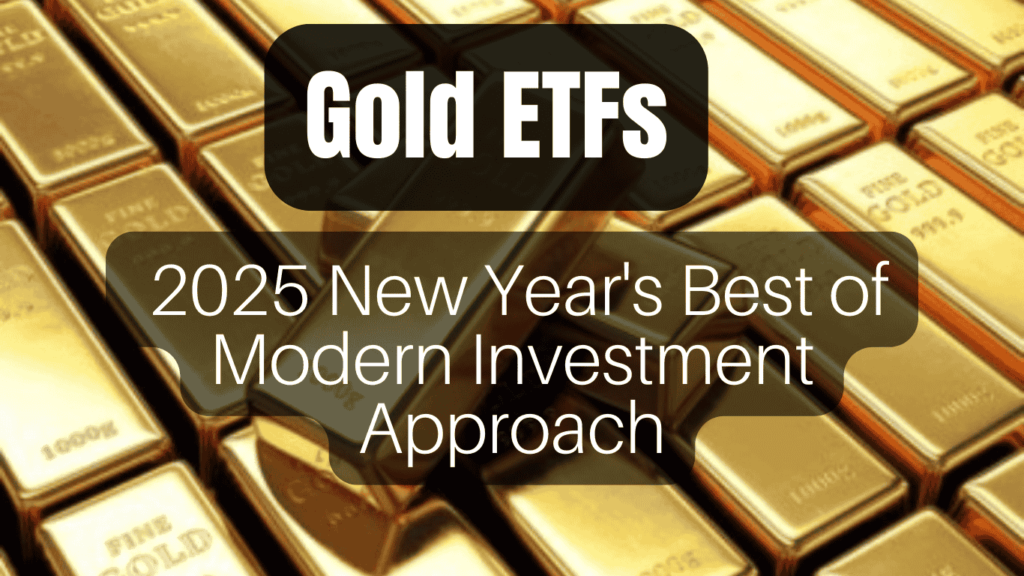Gold ETFs: 2025 New Year’s Best of Modern Investment Approach

Overview
Gold ETFs (Exchange-Traded Funds) are a contemporary and tax-efficient investment vehicle that allows individuals to invest in gold without the complexities associated with physical gold. Let’s explores the concept of gold ETFs, their advantages over traditional gold investments, taxation implications, and their role in a diversified investment portfolio.
Key Points
- What is a gold ETF? Definition and Structure of Gold ETFs: Gold ETFs are designed to mirror the price movements of gold by investing in physical gold or related financial instruments.
- Advantages of Gold ETFs over physical gold products such as jewellery: They offer guaranteed purity, cost efficiency, tax benefits, security against theft, and liquidity compared to physical gold.
- Taxation on Gold ETFs: Changes in tax rules affect short-term and long-term capital gains, making gold ETFs more attractive for medium-term investors.
- Investment Strategy: Gold should be considered a hedge against market volatility rather than a primary investment, serving as a cushion within a diversified portfolio.
- Guidance for Investors: Choosing the right gold ETF involves looking for those with low expense ratios and minimal tracking errors.
Detailed Breakdown
1. Understanding Gold ETFs
A gold ETF is a passive investment that aims to replicate the price movements of gold. Each unit of a gold ETF corresponds to one gram of gold bullion with 99.5% purity. Unlike physical gold, which requires secure storage and carries risks, gold ETFs allow investors to own gold in a digital format. They are traded on stock exchanges, providing liquidity and ease of access. However, the market price of a gold ETF may differ from its Net Asset Value (NAV) due to supply and demand dynamics.
2. Importance of Gold in Investment Portfolios
Gold serves as a reliable hedge against financial instability. Historically, during events like the 2008 financial crisis, gold prices have remained resilient compared to equities and fixed-income assets. This characteristic reinforces the argument for including gold in an investment portfolio, particularly during times of economic uncertainty.
3. Advantages of Gold ETFs Over Physical Gold
Investing in gold ETFs presents several benefits:
- Guaranteed Purity: Gold ETFs are audited to ensure high purity standards, eliminating concerns about receiving inferior quality gold.
- Cost Efficiency: Purchasing physical gold incurs a 3% Goods and Services Tax (GST), whereas gold ETFs are exempt from such taxes.
- Tax Efficiency: The holding period for gold ETFs is one year for long-term capital gains, compared to two years for physical gold, allowing for quicker tax benefits.
- Security Against Theft: Gold ETFs are stored electronically, reducing the risk associated with physical gold storage.
- Liquidity: Gold ETFs can be easily bought or sold during market hours without the hassles associated with physical gold transactions.
4. Taxation on Gold ETFs
Recent changes in tax regulations impact how gains from gold ETFs are taxed:
- Short-Term Capital Gains: Previously, gains from units sold within three years were taxed based on the individual’s income tax slab. Under the new rule effective from April 1, 2023, if units are sold within two years, the entire gain will be added to the taxable income and taxed accordingly.
- Long-Term Capital Gains: Before April 1, 2023, gains from units sold after three years were taxed at 20% with indexation benefits. Under the new rules, gains from investments made after this date will be taxed at the individual’s slab rate if sold within one year of purchase. If sold after one year but before two years, the gains will be taxed at 12.5%.
These changes incentivize medium-term investors to consider gold ETFs over other forms of gold investment.
5. A Modern Approach to Gold Investing
Gold ETFs are recommended for long-term investors looking to diversify their portfolios. They serve as a protective measure against market fluctuations and economic uncertainties. However, it is important to remember that gold should not be viewed purely as an investment but rather as a stabilizing asset within a broader investment strategy.
Investors are advised to select gold ETFs with the lowest expense ratios and tracking errors to maximize their investment efficiency. While choosing a gold ETF is relatively straightforward, constructing a comprehensive investment portfolio may require additional guidance. Tools like Value Research Fund Advisor can assist investors in making informed decisions based on their financial goals.
Important Details & Evidence
- Historical Performance: Gold has historically performed well during financial crises, emphasizing its role as a safe haven.
- Taxation Changes: The introduction of new tax rules as of April 1, 2023, aims to streamline the taxation process for gold ETFs, making them more appealing to investors.
Conclusion
Gold ETFs are a modern, economical, and tax-friendly way to invest in gold, with many advantages over actual gold. They provide as a hedge against economic downturns and are an important part of a diversified investment portfolio.
However, investors should be aware of the tax implications and make sensible choices when using ETFs to supplement their financial objectives. Gold ETFs are worth considering for long-term investors who want to diversify their portfolios, hedge against market swings, or find a safe refuge during difficult times. To select a gold ETF, consider the one with the lowest expense ratio and tracking error.
If you need some helpful advice, Investcorpus Fund Advisors will help you choose the proper gold ETF based on your financial goals.